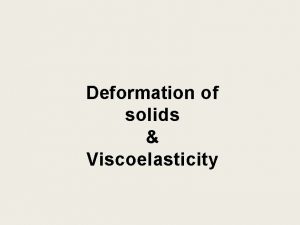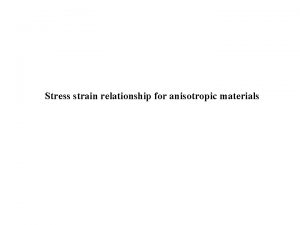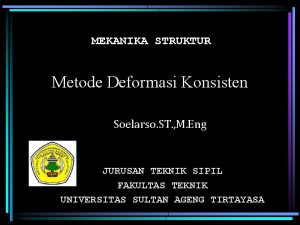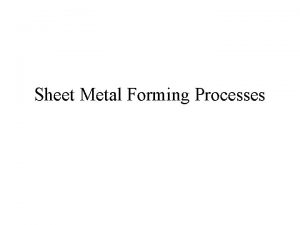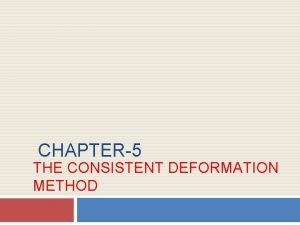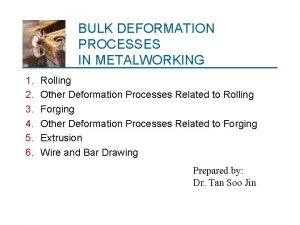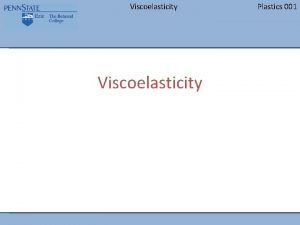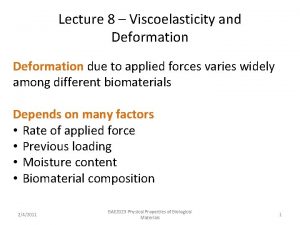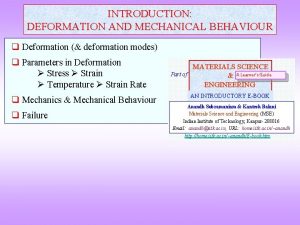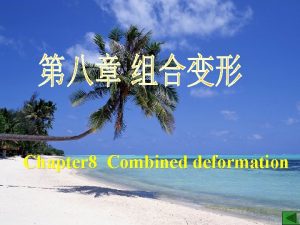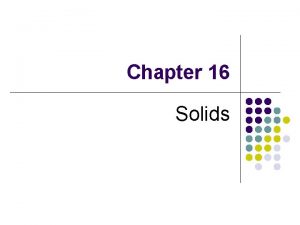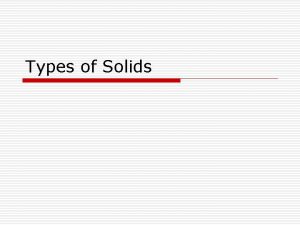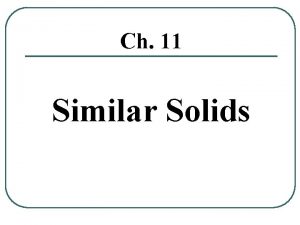Deformation of solids Viscoelasticity Deformation of Solids External













- Slides: 13

Deformation of solids & Viscoelasticity

Deformation of Solids ■ External force can change the shape or size or both of an object. ■ The force is described as strain. ■ As deformation occurs internal inter molecular forces arise that oppose the applied force. ■ If the applied force is not too great, these internal forces are sufficient to completely resists the applied force and allow the object to assume a new equilibrium state and to return to its original state when the load is removed. ■ A larger applied force may lead to a permanent deformation of the object or even to its structure failure. ■ Depending upon the type of material, size and geometry of the object and the forces applied various deformation may result.

Deformation of Solids

Deformation of Solids ■ Types of deformation - Elastic deformation - True stress and strain - Plastic deformation - Fracture

Elastic Deformation § It is reversible. § when the forces are removed, the object tends to its original shape. § Linear elastic deformation is governed by Hooke’s Law σαƐ σ=Eε Where, σ = applied stress, E = material constant called young’s modulus or elastic modulus and Ɛ = the resulting strain.


• The relationship indicates that the slope of stress vs. strain curve can be used to find the elastic or young modulus E. • The elastic range ends when the material reaches its yield strength. • At this point plastic deformation begins.

Young’s Modulus • Tensile stress is the ratio of the external force to the cross-sectional area • SI units of stress are Pascals, Pa – 1 Pa = 1 N/m 2 • The tensile strain is the ratio of the change in length to the original length – Strain is dimensionless • The elastic modulus is called Young’s modulus F A Y L Lo

Plastic Deformation ■ It is irreversible. ■ Object in plastic deformation range will first have undergone elastic deformation which is reversible so the object will partly return to its original shape. ■ Soft thermoplastic materials have rather large plastic deformation range as do ductile metals such as copper, silver and gold. An example of a material with a large plastic deformation range is a wet chewing gum which can be stretched dozens of its times its original length. ■ Hard thermosetting plastics, rubber and ceramics have minimal plastic deformation ranges.

Plastic Deformation ■ Under the tensile stress plastic deformation is characterized as 1. Strain hardening region – material becomes stronger through the movement of atomic dislocations. 2. Necking region – reduction in cross sectional area of specimen. It begins after the ultimate strength is reached. Material can no longer withstand the maximum stress and strain in the specimen rapidly increases 3. Fracture- indicates the end of the plastic deformation

Breaking ■ If stress continues, it surpasses its ultimate strength - The ultimate strength is the greatest stress the object can withstand without breaking ■ The breaking point - For a brittle material, the breaking point is just beyond its ultimate strength - For a ductile material, after passing the ultimate strength the material thins and stretches at a lower stress level before breaking

Viscoelastic properties ■ Viscoelastic materials are those for which the relationship between stress and strain depends on time.

Viscoelastic properties ■ Some phenomena in viscoelastic materials are: (i) if the stress is held constant, the strain increases with time (viscoelastic creep) (ii) if the strain is held constant, the stress decreases with time (viscoelastic relaxation) (iii) the effective stiffness depends on the rate of application of the load (iv) if cyclic loading is applied, hysteresis (a phase lag) occurs, leading to a dissipation of mechanical energy (v) acoustic waves experience attenuation (vi) rebound of an object following an impact is less than 100% (vii) during rolling, frictional resistance occurs
 Viscoelasticity in dentistry
Viscoelasticity in dentistry Viscoelasticity
Viscoelasticity Toughness on a stress strain curve
Toughness on a stress strain curve External-external trips
External-external trips Stress and deformation
Stress and deformation Defect
Defect Metode konsisten deformasi
Metode konsisten deformasi Plunging anticline
Plunging anticline Deformation processes include which of the following
Deformation processes include which of the following Deformation
Deformation Sheet metal introduction
Sheet metal introduction Consistent deformation method is
Consistent deformation method is Bulk deformation and sheet metal forming
Bulk deformation and sheet metal forming Bulk deformation process
Bulk deformation process

